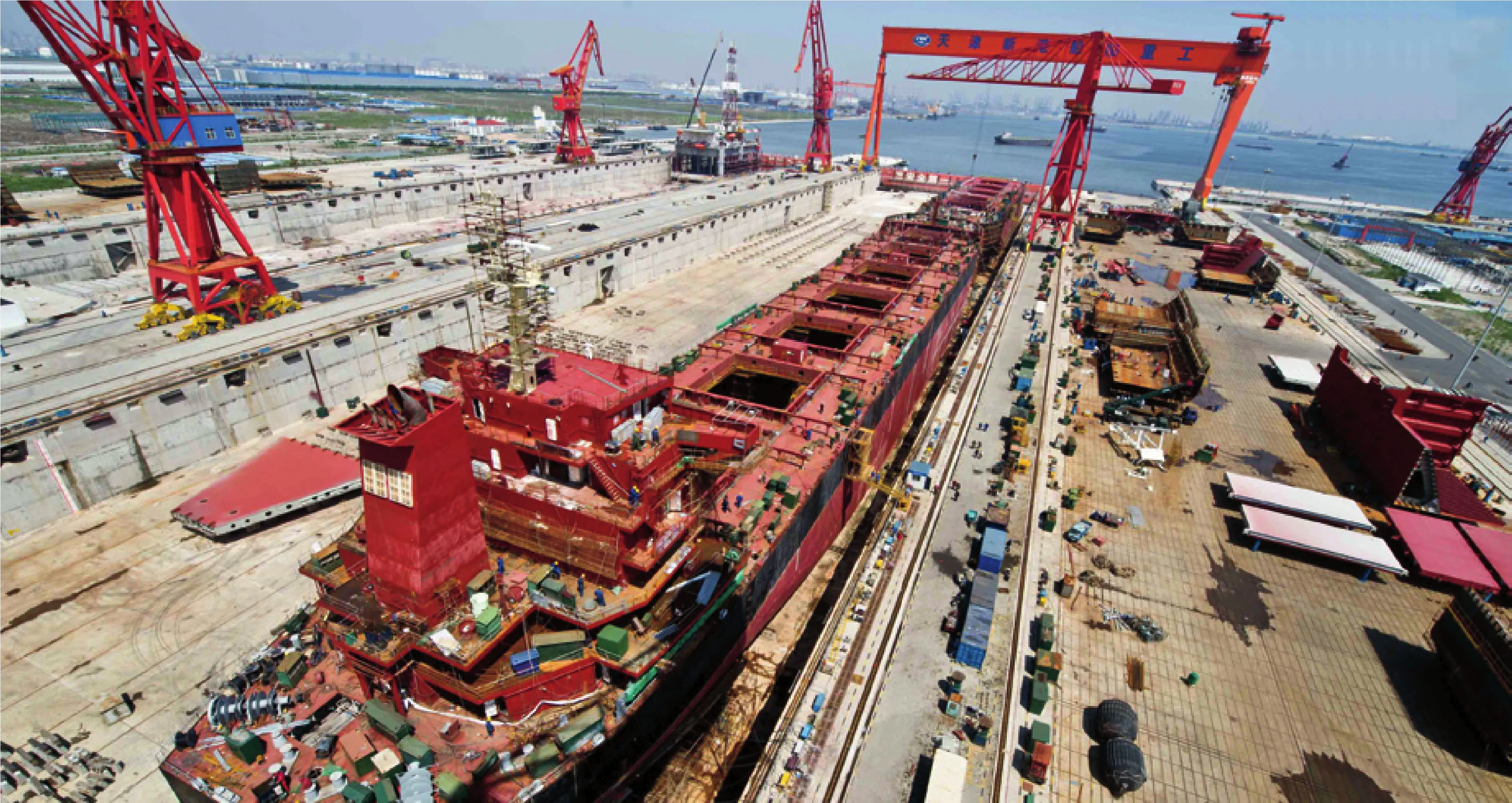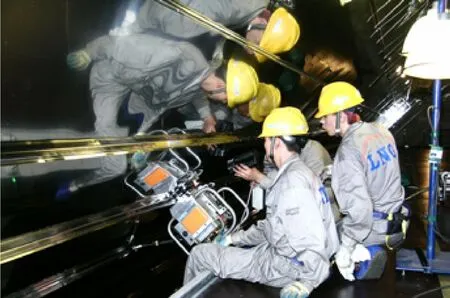ABANDON SHIp ? NOT SO FAST China is set to revitalize its beleaguered shipbuilding sector?
2013-12-07ByLanXinzhen
By Lan Xinzhen

FLOATING GIANT: A ship is under construction at the yard of Tianjin Xingang Shipbuilding Heavy Industry Co. Ltd.
The Hengfu Shipyard, headquartered in east China’s Zhejiang Province,used to be an industrial heavyweight with an annual production capacity of 1 million deadweight tons of vessels. However, the ship producer declared bankruptcy in 2011 due to a lack of orders and mounting debts. Zhejiang Province is clustered with many ship builders operating within private shipyards. But since 2009, many of them have gone belly-up like Hengfu.
Government-backed shipyards are facing tough times, too. The CSSC Jiangnan Heavy Industry Co. Ltd., one of the top five stateowned shipyards in China, recorded a severe loss of 60.31 million yuan ($9.85 million) in the first half of 2013, while its business revenue plunged 39.49 percent year on year. In 2012,the company registered a loss of 97.37 million yuan ($15.91 million).
The combined profits of 80 major ship builders monitored by the Chinese Association of the National Shipbuilding Industry nose-dived by 53.6 percent in the first half of the year to 3.58 billion yuan ($584.1 million), while business revenues plunged 18.5 percent to 120.3 billion yuan ($19.66 billion).
The shipbuilding sector is closely related to 113 other industries, including iron and steel,petrochemical engineering, equipment manufacturing and digital information. The Central Government has expressed deep concerned over the industry’s woes.
China grew to become the world’s leading ship builder over the last decade as hundreds of private yards opened to compete with state-run companies. Now, the government is poised to regain control as the industry heads for consolidation.
To this end, the State Council issued a support plan on August 4 aimed at keeping the shipbuilding sector afloat. The three-year plan for the industry includes controlling capacity,upgrading shipbuilding standards and developing higher value-added products.
Capacity glut

MASTERING THE TECHNOLOGY: Staff members from the China State Shipbuilding Corp. piece together an LNG ship
The shipbuilding sector is capital-, technology- and labor-intensive, with an extremely long industrial chain. It has been a highly competitive industrial field that major global powers have participated in. China is no exception. The export-oriented economy took off in China after the country entered the WTO in 2001, leading to a boom in the country’s shipbuilding sector.
From 2002 to 2010, the number of shipyards with a production capacity of 300,000 deadweight tons or above increased from five to 33, while the number of yards with a capacity of 100,000 deadweight tons or above surged from 13 to 59. The number of shipyards in China has swollen to over 1,600,among which 60 percent were built after 2001.
In 2010, China overtook South Korea to become the world’s largest ship builder after it outdid its rival on new orders and shipbuilding capacity. Just when China’s shipbuilding sector embarked on a fast track of development, the global financial crisis erupted, resulting in falling new ship orders.
“The dilemma of China’s shipbuilding sector is a result of sluggish foreign trade, but also a result of earlier rampant expansion,” said Li Zuojun, a research fellow at the Development Research Center of the State Council.
Li attributed the heavy losses in the shipbuilding industry to “crazy expansion” over the past several years, when bank loans and private capital flocked to the sector. “Many shipyards produced vessels even before receiving orders,resulting in severe excess capacity. Later, the downturn in the global economy made things worse.”
“Chinese ship builders lack strong innovation, while overcapacity persists and ocean engineering equipment development lags far behind,” said Li.
To boost the sector, the Ministry of Industry and Information Technology issued a support plan in June 2009 to ensure shipyards have easier access to credit. Thus, local banks gave the green light to private yards, intensifying the overcapacity problem. The production capacity of shipyards soared to 50 million deadweight tons in 2011.
But only 50 percent of the capacity was eventually utilized in 2012. “A reasonable rate of capacity utilization should be over 85 percent,”said Li. Chinese-made ships are mainly bulk freighters, tank ships and container ships, while high-end technology is lacking. “Excess capacity persists in lower value-added products,” he said.
Time to upgrade
The newly released three-year support plan is targeted at an industrial upgrade to make China a shipbuilding and maritime power, said Li Yanqing, President of China Shipbuilding Information Center. “An outdated development model will only cause further harm to shipyards.Only by accelerating structural adjustment and industrial upgrade can they effectively face new competition and find a way forward,” he said.
Wang Jinlian, Secretary General of the Chinese Association of the National Shipbuilding Industry, said the new plan not only regulates the control of capacity, but also speci fies how the industry can upgrade and become stronger.
“After several years of development,China’s shipbuilding industry has accumulated competitiveness in raw materials and labor. Global shipbuilding is gradually being transferred to China, which has the ability to push its shipbuilding sector to a new level,”said Wang.
The global shipping market has been mired in a continuous slowdown after the global financial crisis and falling new orders have dragged down the price of new vessels. This has intensified the overcapacity issue, posing significant challenges to the sector’s development. “But we should also bear in mind that China has already built an array of high-level shipbuilding infrastructure, with complete upstream and downstream industries, abundant labor resources and a potential domestic market,”said Wang.
Wang said Chinese-made vessels are still mainly low value-added ones, while Japan and South Korea have a lead in new technology. According to global shipbuilding standards, new-generation shipbuilding technology is mainly focused on saving energy,reducing emissions, information technology and smart designs.
“Chinese vessel makers should have the faith to seize global trends, which entails severely adjusting their industrial structure,” said Wang.
Forward and beyond
Li Yanqing said the new plan has given powerful shipyards more incentive to upgrade. “In the future, China’s shipbuilding industry will come up with more innovations in shipbuilding technology, develop more higher-end and green shipbuilding and expand overseas,” he said.
Li Yanqing predicted changes in the sector in the next several years—for instance,outdated and excess capacity will gradually be phased out and investment will flow to higher-end fields. Even before the new plan was rolled out, most shipyards realized their high numbers were a disaster for the sector and began to upgrade.
One example is the China State Shipbuilding Corp., which has invested heavily in research and development and adjusting its product portfolio. The proportion of high-end vessel orders has increased tremendously, including large container ships,multi-functional ocean engineering ships and large LNG ships.
Li Yanqing said that under the new plan, capital and the markets will favor shipyards manufacturing higher value-added products.
“China State Shipbuilding Corp. has turned to high-end and green production. More and more Chinese yards will follow suit.” ■

A BREAKTHROUGH: An LNG ship made by the Shanghai-based Hudong-Zhonghua Shipbuilding (Group) Co. Ltd.was delivered to the ship buyer on April 3, 2008. This was the first of its kind for China’s shipbuilding industry
Major Tasks in the plan
● Accelerate technology innovation and realize innovation-driven development;
● Improve production levels for key equipment and materials;
在风景园林建设的多种要素中,植物和植物景观是与碳循环有着密切联系的核心要素[4]。因为在绿道建设中其他要素低碳效应在于减少碳排放,而植物和植物景观既与减少碳排放有关,又与碳固定有联系,因此在绿道规划设计中,需要找到合适的植物景观规划设计策略,才能最大化的减少碳排放。
● Adjust and optimize the layout of vessel production;
● Facilitate the development of high-end products;
● Stabilize the industry’s international market share;
● Urge more military-civilian cooperation in vessel design and development;
● Strengthen company management and services.
Shipbuilding H1 2013
The completed orders, new orders and total orders in Chinese shipyards accounted for 39.1 percent, 44.2 percent and 43.1 percent of the world total, respectively.
Chinese shipyards built 20.6 million deadweight tons of vessels, down 36 percent year on year. They received new orders for 22.9 deadweight tons of vessels.
Completed vessels for exports were 17.28 deadweight tons, down 34.4 percent, and new orders for vessel exports were 21.04 million deadweight tons, up 163.3 percent. At the end of June, total orders for vessel exports were 95.14 million deadweight tons, down 11.3 percent year on year. Completed orders, new orders and total orders for vessel exports accounted for 83.9 percent, 91.9 percent and 87.3 percent of the national total, respectively.
(Source: Chinese Association of the National Shipbuilding Industry)
猜你喜欢
杂志排行
Beijing Review的其它文章
- promoting Trade Foreign trade can play a bigger role in ensuring stable economic growth
- Mind Your Own e-Business! More job hunters start business careers on the Internet
- Seeking a Cure Cities are upgrading drainage systems to battle chronic flooding
- Trying a New Way Beijing NGO launches a charity program to encourage carpooling
- Who Wants to Be Number Two?Imagining a future beyond the superpower paradigm
- A Needed Reform Interest rates must be fully liberalized to meet the demands of the market
